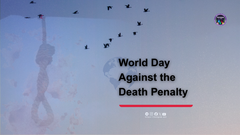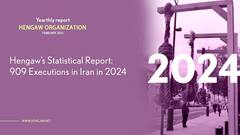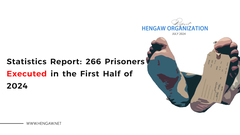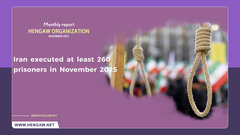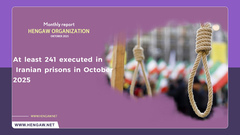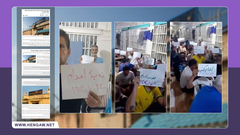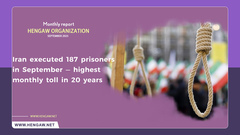Hengaw's Statistical Report on the Implementation of the Death Sentence in Iran in 2023
According to data registered in the Statistics and Documentation Center of the Hengaw Organization for
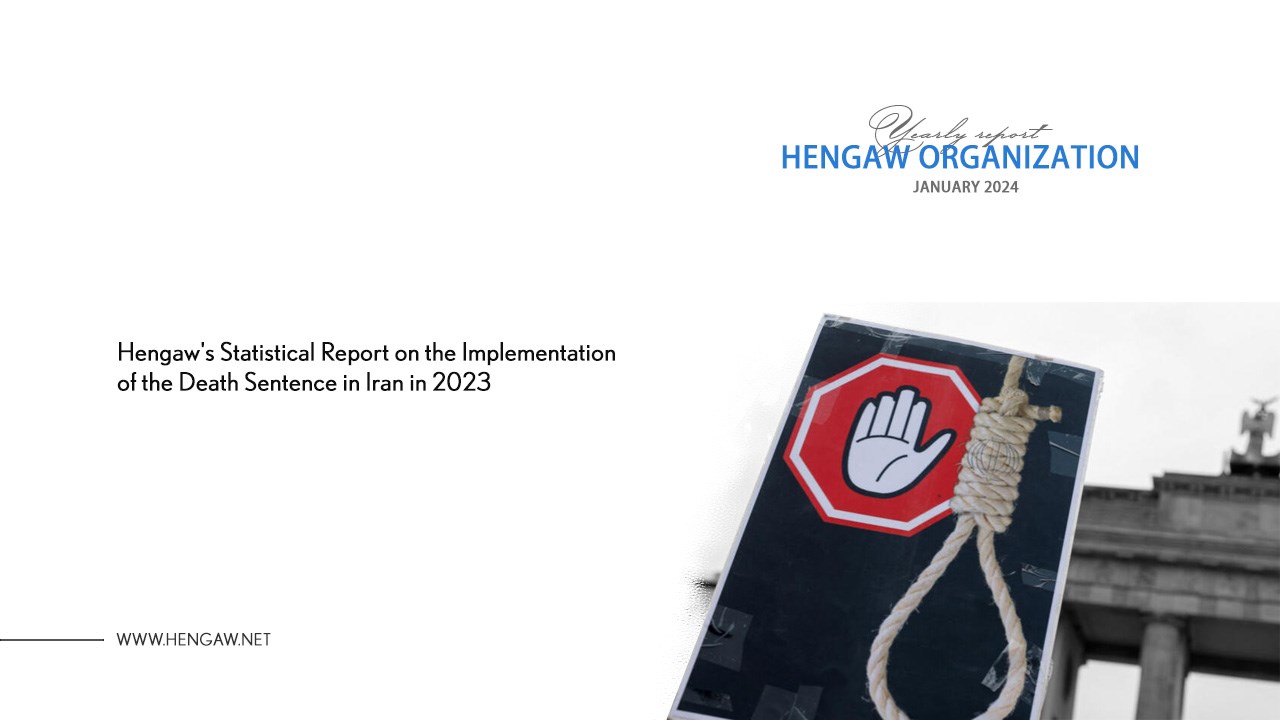
Hengaw: Wednesday, January 24, 2024
According to data registered in the Statistics and Documentation Center of the Hengaw Organization for Human Rights, in the year 2023, a total of 829 prisoners were executed in various Iranian prisons, with six of these executions taking place in public. Additionally, during the same period, 22 women and five children were sentenced to death in the prisons of the Islamic Republic of Iran.
This statistic represents a significant increase of 289 cases, equivalent to 53.5%, in comparison to the year 2022, when 540 prisoners were executed in the prisons of the Islamic Republic of Iran. Executions took place in all 31 provinces of Iran, with the highest number of 166 cases recorded in Alborz province.
Out of the 829 prisoners whose executions have been documented by Hengaw, the full identities of 678 have been verified, while the identities of 151 individuals are currently under investigation.
In addition to the special reports received by The Hengaw Organization for Human Rights and our colleagues within Iran, this report has utilized information obtained through contacts with the families of numerous executed individuals. Moreover, data from various other human rights organizations active in Iran, approved by Hengaw, has been incorporated. It is worth noting that some cases published by these organizations are not included in this report due to the lack of approval by Hengaw. The challenges of transparency and the associated risks of disclosing cases of death sentences against human rights defenders and civil activists contribute to the incompleteness of this statistic. Undoubtedly, the actual statistics are higher than those presented in this report.
This report comprises 11 separate sections with tables and graphs:
1. Separation of executed prisoners according to charges
2. The execution of political and religious prisoners
3. The execution of child criminals
4. The execution of women
5. Separation according to national and ethnic minorities
6. The execution of Kurdish prisoners
7. The execution of Baloch prisoners
8. The execution of Afghan prisoners
9. Separation of execution of death sentences according to provinces
10. Execution in public
11. Conclusion
Separation of Executions According to Charges
In 2023, according to statistics recorded by the Statistics and Documentation Center of The Hengaw Organization for Human Rights, the majority of executions were associated with individuals sentenced to death by the judicial system of the Islamic Republic of Iran on charges of drug-related crimes. Specifically, 56% of the executions, amounting to 464 cases, were related to drug-related offenses.
Breakdown of executions according to charges:
1. Drug-related crimes: 464 cases, representing 56% of all cases.
2. Political and religious activity: 31 cases, accounting for 4% of all cases.
3. Homicide: 294 cases, constituting 35% of all cases.
4. Rape: 24 cases, comprising 3% of all cases.
5. Armed robbery: 6 cases, making up 1% of all cases.
6. Unknown: 10 cases, contributing to 1% of the total cases.
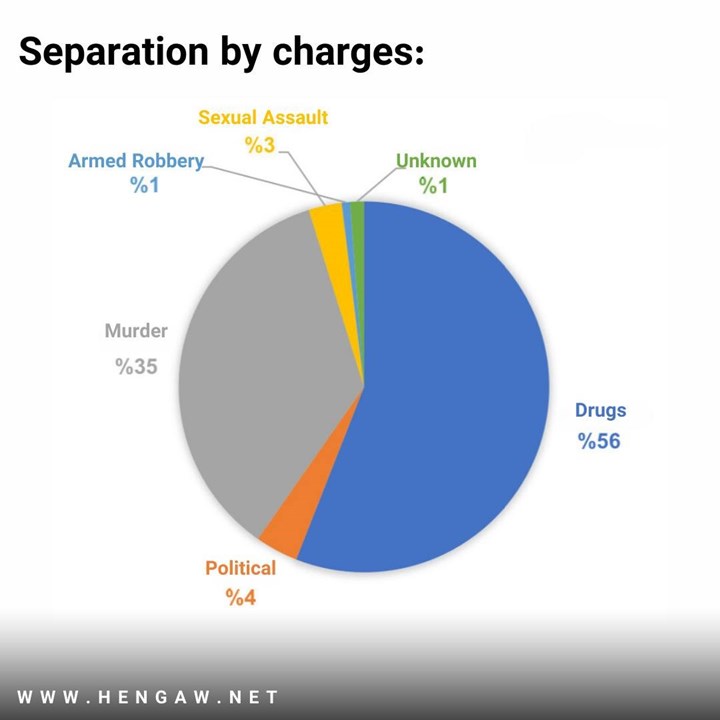
Execution of 31 Political and Religious Prisoners in 2023
In the year 2023, a total of 31 prisoners, previously charged by the judicial system of the Islamic Republic of Iran for engaging in political and religious activities, including accusations such as "insulting the prophet of Islam" (Sab al-Nabi), were executed in Iranian prisons.
This report outlines the breakdown of charges: According to this report, 11 people were charged with political activity, 6 people were charged with espionage for foreign countries, 6 people were charged with participating in the Jin, Jiyan, Azadi movement, 2 people were charged with participating in the protests of November (Aban) 2019, 2 people were charged with "insulting the prophet of Islam" (Sab al-Nabi), and two Afghan nationals were accused of armed attacks in Shahcheragh, Shiraz.
The list of executed political and religious prisoners is provided below.
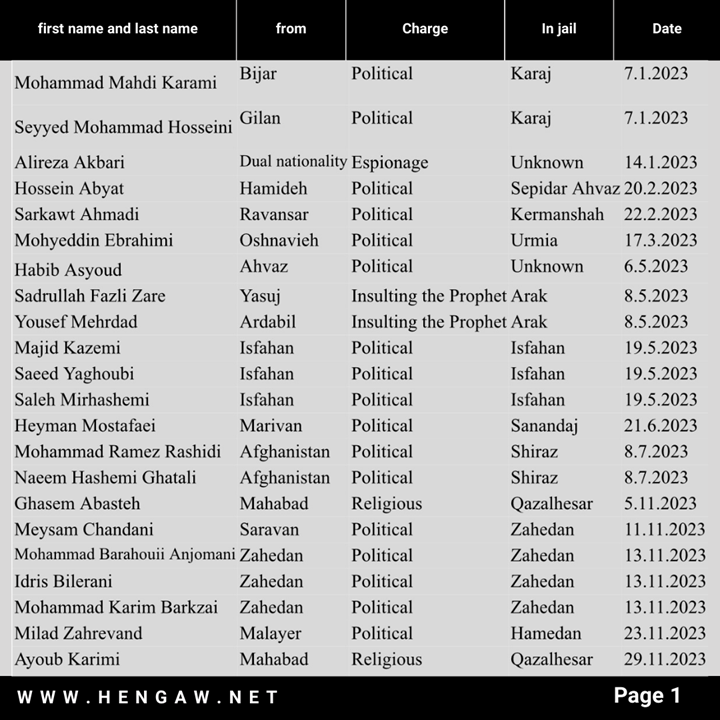
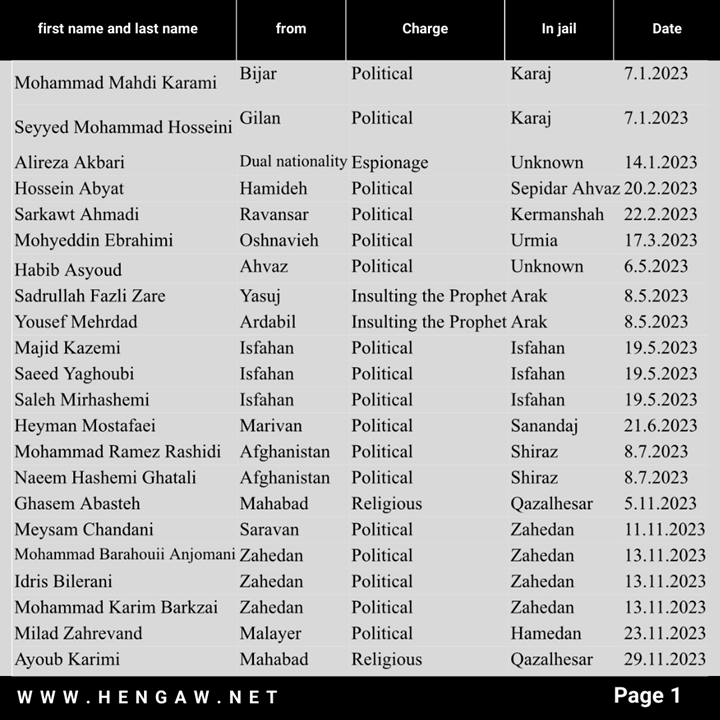
Execution of Five Child Criminals in 2023
Hengaw's statistics in 2023 reveal the execution of at least five individuals classified as child criminals. These executions took place in Khorram Abad prisons (2 cases), Chabahar, Sabzevar, and Ghezel Hesar prisons in Karaj. Notably, these five individuals were under the age of 18 when they committed the crimes.
Despite the global consensus reflected in the United Nations Convention on the Rights of the Child, which has been signed and ratified by most countries, the Islamic Republic of Iran continues to execute death sentences for individuals under the age of 18. This practice contradicts the explicit prohibition of harsh or cruel punishments, including execution, for persons under the age of 18 as outlined in the Convention.
The names of the executed children and their respective cases are as follows:
1. Mohammad Javad Akbari, 19 years old, from Kohdasht, was executed on February 2, 2023, in Parsilon prison in Khorramabad, charged with drug-related crimes. He was 16 years old at the time of the crime.
2. Abolfazl Bayat, 20 years old, from Robat Karim, was executed on September 27, 2023, in Ghezel Hesar prison in Karaj, charged with homicide. He was 16 years old at the time of the crime.
3. Ali Najafi from Kohdasht, executed on September 27, 2023, in Parsilon prison in Khorramabad, was charged with homicide. He was 17 years old at the time of the crime.
4. Hamid Azari, 17 years old, from Sabzevar, was executed on November 24, 2023, in Sabzevar Central Prison, charged with homicide. He was 16 years old at the time of the crime.
5. Adel Damani, 25 years old, from Chabahar, was executed on November 26, 2023, in Chabahar Central Prison, charged with homicide. He was 16 years old at the time of the crime.
At least 22 women were executed last year.
Last year, at least 22 women were executed in various prisons across Iran, constituting 2.7% of the total number of executions. According to the Hengaw Statistics Center, 68% of these women were sentenced to death by the judicial system of the Islamic Republic of Iran on charges of homicide. The charges included one woman sentenced to death for espionage for Israel, and three women sentenced to death for drug-related crimes. Unfortunately, detailed information about the charges against the remaining three women is not available.
Isfahan and Birjand prisons witnessed the highest number of executions of women, each with four cases. Additionally, two women each were executed in Mashhad, Rajaei Shahr, Karaj, and Kerman prisons, and one woman each in Rasht, Zahedan, Qom, Kahnuj, Hamadan, Yasuj, Urmia, and Ghezel Hesar prisons.
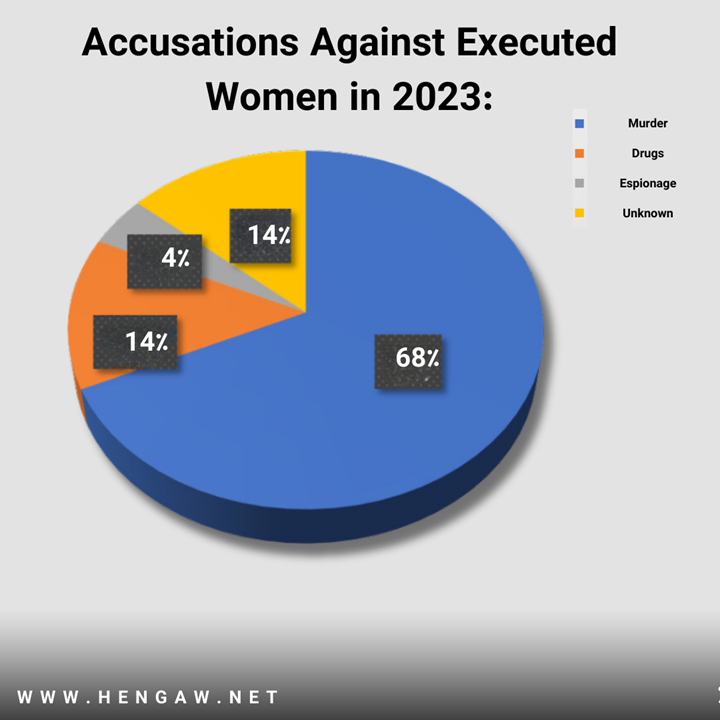
Separation of Executions in Iran According to National and Ethnic Minorities
In 2023, according to the Statistics and Documentation Center of The Hengaw Organization for Human Rights, the highest number of executions occurred among the Baloch national minority, with 183 cases, constituting 22.8% of the total executions. Additionally, 151 Kurds were executed, representing 18.2% of all cases in Iranian prisons during the same period.
According to this report, 55 Turkish prisoners, 48 Lor and Lor Bakhtiari prisoners, 28 Afghan national prisoners, 27 Gilak prisoners, 9 Arab prisoners, 3 Turkmen prisoners, and two dual citizenship prisoners were also executed in the prisons of the Islamic Republic of Iran last year.
Additionally, 168 executed prisoners are from the Persian nation, while detailed information about the nationality of the remaining 155 prisoners is not available.
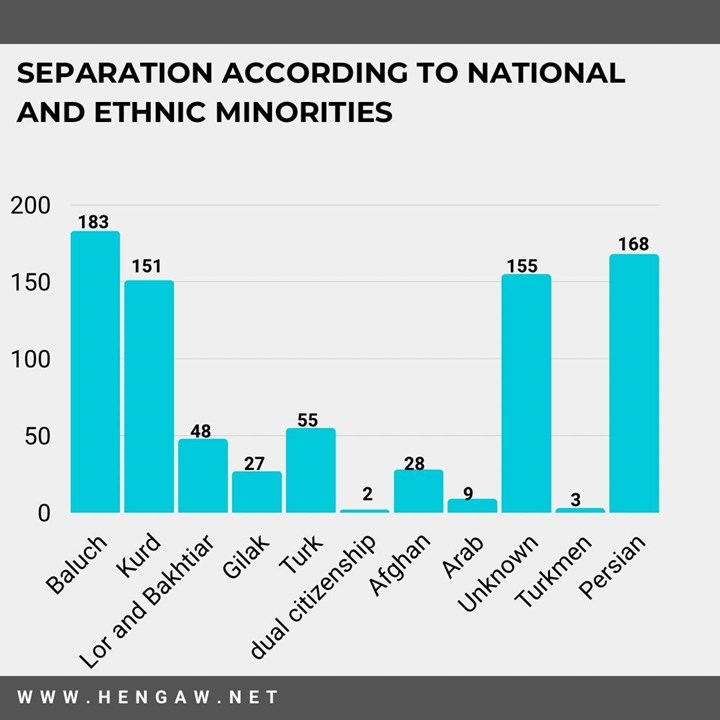
Surge in Execution of Kurdish Prisoners: 190% Increase from the Previous Year
In the year 2023, the Statistics and Documentation Center of the Hengaw Organization for Human Rights documented a significant increase in the execution of Kurdish prisoners, with at least 151 cases in Iranian prisons. This marks a stark rise of 190%, representing an increase of 99 cases compared to the previous year, when 52 Kurdish prisoners were executed.
At least nine Kurdish political prisoners were executed in 2023, accounting for 30% of the total number of individuals executed for political and religious activities throughout Iran during the same period.
The majority of these executions, 58%, involved Kurdish prisoners sentenced to death for drug-related crimes. Additionally, 53 prisoners faced execution for homicide, nine for political and religious activities, and one for rape.
The prisons with the highest number of executions of Kurdish prisoners in 2023 include Urmia Central Prison (28 cases), Ghezel Hesar Prison in Karaj (20 cases), Kermanshah Central Prison (18 cases), Karaj Central Prison (16 cases), Parsilon Prison in Khorramabad (15 cases), Sanandaj Central Prison (14 cases), Hamadan Central Prison (9 cases), Ilam Central Prison (7 cases), Arak (4 cases), Selmas (4 cases), Saqqez Prison (3 cases), and Rasht Prison (2 cases) each.
Moreover, one Kurdish prisoner each was executed in the prisons of Ardabil, Aliguderz, Bandar Abbas, Birjand, Khoy, Dezful, Zahedan, Shiraz, Shirvan, Maku, and Naghadeh.
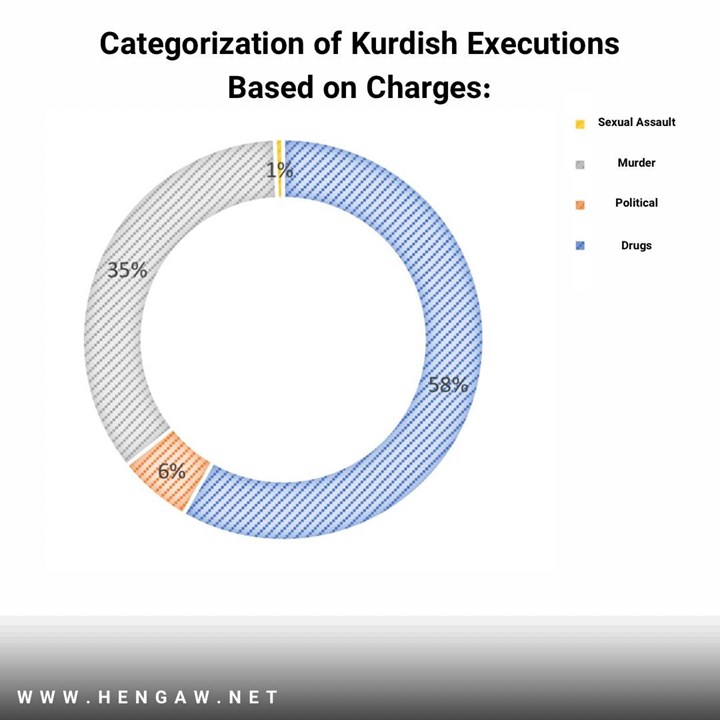
Balochs Experienced the Highest Number of Executions Last Year
According to this report, in 2023, at least 183 Baloch individuals were executed in various prisons across Iran, accounting for 22.8% of the total executions in the country last year.
Among the executed Baloch individuals, at least six were Baloch political prisoners, including three women and one child. More than 81% of the Baloch prisoners executed (149 cases) faced the death penalty for drug-related crimes. Additionally, six Baloch political prisoners were executed, and 27 individuals received death sentences for charges related to homicide, while one prisoner faced the death penalty for rape.
The province with the highest number of Baloch executions was Sistan-Balouchistan, recording 60 cases. Furthermore, there were 38 cases in Kerman province, 34 cases in South Khorasan province, 13 cases in Hormozgan province, 12 cases in Razavi Khorasan province, 7 cases each in Shiraz and Isfahan provinces, and 3 cases in Yazd province. 2 cases in Golestan, Semnan, and Alborz provinces each. Additionally, one case was reported in both Mazandaran and Qom provinces.
Execution of 28 Afghan Citizens in Iranian Prisons
In 2023, a minimum of 28 Afghan prisoners faced execution in the prisons of the Islamic Republic of Iran, representing 2.7% of the total executions in the country last year.
Over 68% of these cases (15 cases) involved individuals sentenced to death for homicide charges by the judicial system of the Islamic Republic of Iran. The report further details that two prisoners faced execution for an armed attack on Shahcheragh of Shiraz, with their sentences carried out in public. Additionally, nine prisoners accused of drug-related crimes and two prisoners accused of rape were also executed.
Ghezel Hesar Prison in Karaj recorded the highest number of executions of Afghan national prisoners, totaling 10 cases. Furthermore, four prisoners were executed in Shiraz prisons, three prisoners in Zabul, and two prisoners each in Kerman Central Prison and Karaj Central Prison. In addition, Zahedan, Rodan, Khorram Abad, Aligudarz, Yazd, and Isfahan prisons each executed one Afghan citizen.
One Fifth of Executions in 2023 Occurred in Alborz Province Prisons
According to Hengaw statistics, a staggering 20% of the total executions in 2023 took place in three prisons in Alborz province—Rajaei Shahr, Karaj Central Prison, and Ghezel Hesar—amounting to at least 166 prisoners.
Following Alborz province, the second-highest number of executions was reported in Sistan- Balochistan province, with 69 cases. Additionally, significant numbers were recorded in the prisons of Kerman province (68 cases), Fars province (56 cases), Isfahan province (50 cases), South Khorasan province (46 cases), West Azarbaijan province (44 cases), Lorestan province (43 cases), Hormozgan province (33 cases), and Central province (23 cases). Regions with 21 cases each included Gilan, Razavi Khorasan, and East Azerbaijan provinces.
Notably, Kurdistan and Kermanshah provinces reported 18 cases each; Ardabil had 17 cases; Khuzestan recorded 15 cases; and Golestan and Qazvin each had 12 cases. Qom reported 10 cases, Zanjan had 9 cases. Ilam Province, and Kohgiluyeh and Boyer-Ahmad Province each had 7 cases. Yazd recorded 6 cases, and North Khorasan had 4 cases.
According to Hengaw’s data, there were two cases of execution in Semnan province, and the lowest number of executions were reported in Tehran and Bushehr provinces, each with one case. Additionally, the locations of two executed prisoners remain unknown.
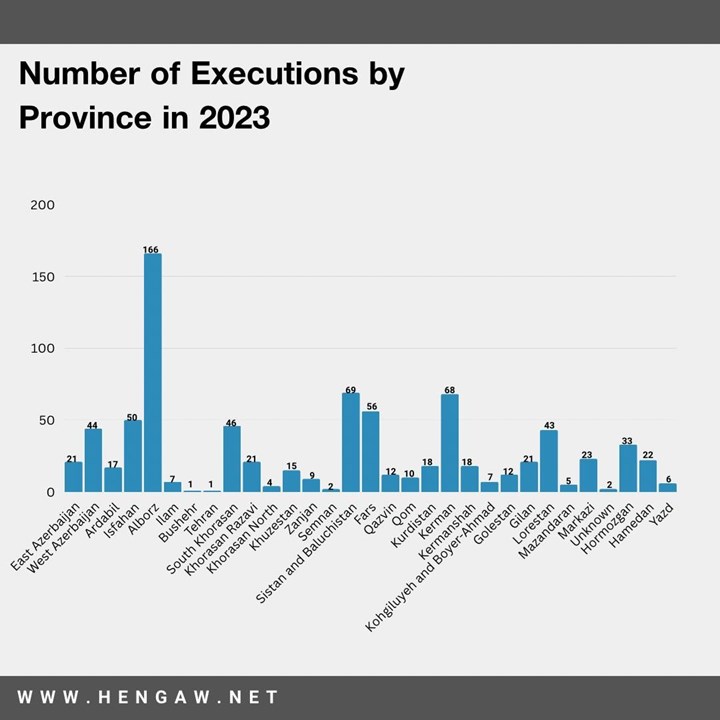
Execution of Six Prisoners in Public
Public execution, a stark violation of human dignity, finds no place in a civil society. Regrettably, it is employed as a political tool to intimidate and suppress opposition, conflicting with democratic principles. The Islamic Republic of Iran has consistently utilized this method to instill fear in society.
This report reveals that, in 2023, at least six prisoners, including two Afghan nationals, accused of an armed attack on Shahcheragh Shiraz, faced public execution. These instances occurred in Shiraz (2 cases), Foladshahr of Isfahan (2 cases), and 1 case each in the cities of Bandar-e Deylam and Maragheh.
Conclusion:
Hengaw emphasizes that the Islamic Republic's policy, marked by widespread human rights violations, especially through mass executions, can only be internationally prosecuted when the various forms and details of these executions are scrutinized through the examination of recorded statistics, particularly concerning different social groups.
While alerting to the escalating repressive measures during the Women, Life, Freedom/Jin, Jiyan, Azadi movement in Iran, the Hengaw Organization for Human Rights urges the international community and institutions devoted to human rights to take stronger stances against these violations. It underscores that the Islamic Republic's execution policy, acting as a tool of repression, involves citizens executed for reasons including poverty, systematic discrimination based on ethnic groups, and a lack of transparency within the judicial system. International institutions are urged to implement serious practical consequences for the rampant executions by categorizing them as part of the Islamic Republic's killing policy.
